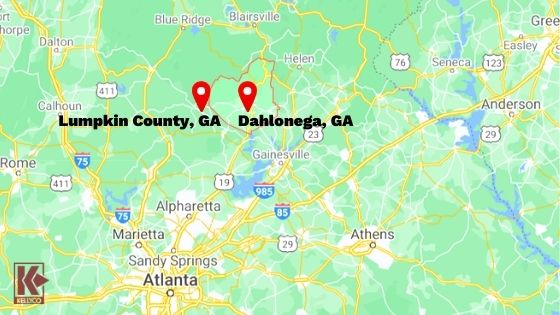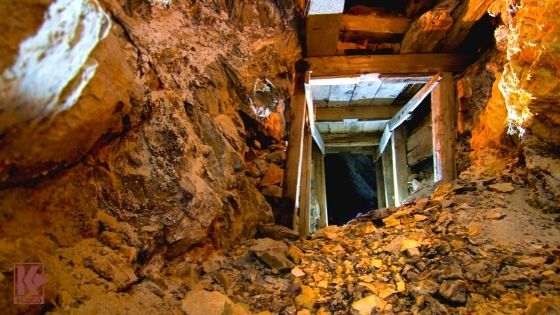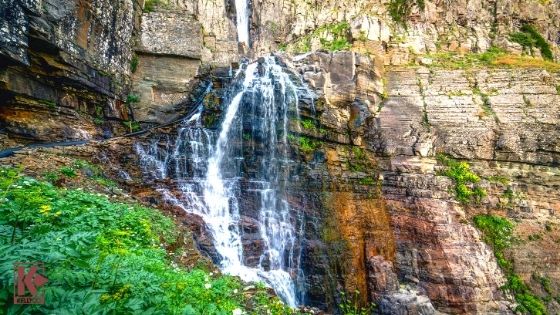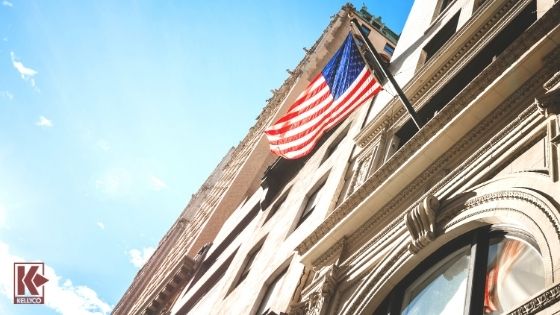The Georgia Gold Rush
Published by Sam Jacobs on 10/07/20

The Georgia Gold Rush
The Carolina Gold Rush may have been America’s first gold rush and kicked off the American lust for finding gold, but the Georgia Gold Rush, also known as the Dahlonega Gold Rush, followed quickly thereafter and was where many of the men from the Carolinas went after the low-hanging fruit had all been panned out of rivers or mined. In terms of national consciousness, the Georgia Gold Rush quickly came to outshine the Carolina Gold Rush, despite the fact that Carolina’s gold region was the powerhouse of American gold until the discovery of gold in California in the mid-19th Century.
It all began in 1829 in Lumpkin County, Georgia, situated in the north-central part of the state and 65 miles from Atlanta. This was still relatively untamed at the time, certainly so when compared to the Carolinas. It had long been known that there was gold in this region. The Native Americans told explorers that the small discoveries that they had originated were from the hillsides and mountains nearby.
There is some poorly attested Spanish and French gold mining in the region dating back to the colonial period, but nothing significant to speak of. However, there is an open question of why the gold crazy Spanish would have abandoned these mines. This means that the Spanish either never found gold or weren’t very good at extracting it and considered the area to be a bit of a dead-end, though the former is much more plausible.
The connection between the Georgia Gold Rush and the Carolina Gold Rush is more than just temporal and geographic. It is, in fact, the very same vein of gold that runs throughout the region. So in a sense, the Georgia Gold Rush can be seen as sub-gold rush days of the Carolina Gold Rush — an echo of it, as it were.
How Did the Georgia Gold Rush Start?

Prospecting Gold
Unlike the Carolina Gold Rush, no one is positive about who first struck gold in the region. Some of the most popular versions of events are that a man named Frank Logan (or, in some tellings, his slave) first discovered the gold in White County, Georgia at Duke’s Creek. Others say that the gold was indeed found in White County at Duke’s Creek, but that it was found by John Witherood rather than Frank Logan. Others say that Jesse Hogan, fresh from prospecting in North Carolina first struck near Dahlonega, Georgia, at Ward’s Creek. Another version of the Duke’s Creek theory has Thomas Bowen first discovering gold sitting in the roots of a tree overblown by a story. Finally, others say that Benjamin Parks celebrated his birthday in 1828 by striking gold walking along a deer path, choosing to lease the land from Reverend O’Barr with his business partner, Joel Stephens.
The problem with all of these theories is that there is no contemporaneous document to verify any of them. The historical record is nonexistent as to who first kicked off the Georgia Gold Rush. There might have been contemporaneous accounts, but they have been lost to the sands of time, leaving us to simply speculate about which or another theory of who first found gold there might be more plausible.
Whoever it was that first struck gold in Georgia in 1828, we do know that the gold rush itself began in earnest in 1829. On this, we have some evidence in the historical record. A notice ran on August 1, 1829, in the Georgia Journal (a newspaper for the Milledgeville community) declared that there were two mines in the area and that men were seeking their fortunes there. At around the same time, the Macon Telegraph reported discoveries in the winter of 1829 and 1830. This report isn’t simply about gold being found, but about an influx of men into the region to mine, representing a contemporaneous account not just of finding gold, but of the Georgia Gold Rush itself.
Newcomers Descend on Cherokee Land

Treasure Awaits
Carroll County, Georgia was the next site of gold discovery in 1830. Much of this was found on land that was, at least in theory, owned by the Cherokee people. However, this did not stop the Great Intrusion – when miners of European extraction descended upon the region in search of treasure. Lumpkin, White, Union, and Cherokee counties became overwhelmed with prospectors hunting for gold in the gold mines. Most of this was placer mining. Contemporary accounts put a whopping 4,000 miners just at the Yahoola Creek site. In a single area north of Blairsville, there were over 300 ounces of gold being found every day. In 1830 alone, the Philadelphia Mint received $212,000 in gold from Georgia.
By 1830, there were between 6,000 and 10,000 miners working between the Chestatee River and the Etowah River. Boomtowns such as Auraria and Dahlonega sprung up as a result of the gold fever, and Dahlonega grew to hold the county seat in Lumpkin county. Dahlonega alone is said to have had as many as 15,000 miners during the height of the gold rush. For context, the 10th largest city in America in 1830, Southwark, Pennsylvania, had barely 20,000 residents that same year.
Needless to say, this influx of Americans working in the mines that were springing up throughout the entire North Georgia region created a lot of tension with the Cherokee who nominally owned the area. The tension came to a head in what is known popularly as the Trail of Tears — the forced migration of the Cherokee people from their ancestral lands in North Georgia and vicinity to what was then known as “Indian Country” in present-day southwest Oklahoma. Many of the Cherokee people continue to live in this region to this day. Indeed, the Indian Removal Act of 1830 is a direct result of the American lust for gold on land that had been occupied by the Cherokee people.
The Cherokee turned to the court system to attempt to protect themselves from this forced removal from their lands.

The Cherokee
And, indeed, the Supreme Court found in their favor in Worcester v. Georgia in 1832. This recognized the Cherokee as a sovereign nation. However, in one of the most famous Presidential actions of all time, Andrew Jackson simply ignored the order saying “John Marshall has made his decision; now let him enforce it.” That same year, the Philadelphia Mint received half a million dollars in gold from Georgia equivalent to $15.1 million in 2020 dollars.
The State of Georgia held the Georgia Gold Lottery in 1832. This was the seventh such land lottery. Tickets were sold for $10 each. To be eligible, one needed to be a bachelor over the age of 18 who had resided within Georgia for the last three years and were citizens of the United States. The same rules except for the age limit applied to orphans, married men, and widowers. Excluded from the lottery were previous winners of lotteries, convicted felons, anyone who had mined or profited from mining on former Cherokee territories prior to June 1, 1830, and members of “a horde of Thieves known as the Pony Club.” A second lottery for the remaining lands was held in 1833.
By 1838, Georgia was producing so much gold that the Dahlonega Mint began operation. This was particularly poor timing because gold in the region began to “play out” by the 1840s, meaning that there wasn’t much gold left to be mined at all, let alone by inexperienced amateurs with crude tools. Much more sophisticated and intensive efforts would be required to get the remainder of the gold out of the ground.
California Steals Away Dahlonega’s Prospectors

The Fall Of The Georgia Gold Rush
The assayer of the Dahlonega Mint, M. F. Stephenson, implored miners not to leave for California from the steps of the local courthouse as they prepared to leave for the Golden State. “Why go to California? In that ridge lies more gold than man ever dreamt of. There’s millions in it.” His pleas largely fell on deaf ears.
The California Gold Rush put a final end to the Georgia Gold Rush as it did to many other areas of mining in the United States at the time. There was a sharp decrease in the number of men looking for gold nuggets or working as professional miners in the region. However, the production of gold from Georgia did not cease — not by a long shot. Hydraulic mining and blast mining were the preferred methods rather than panning or placer mining. All told, 37 counties boasted 500 working mines until the beginning of the Civil War, which largely brought gold mining in the region to a halt, as men were needed both to fight and to equip the Confederate Army.
After the war, mining began anew at some of the older mines and several were reopened during the Great Depression when the Federal government needed gold so badly that it confiscated it from American citizens under penalty of prison for those who did not comply. Commercial production of gold in Georgia finally came to a close in the mid-20th Century, but there had been a lot of work done before then: The entire state of Georgia produced 870,000 troy ounces (24,000 kilograms) of gold between the first discovery in 1828 and when commercial production ceased.
But what of the Cherokee? While their removal from their ancestral lands was certainly a tragedy for this Native American tribe, they left with their knowledge of how to mine gold intact. This meant that many of them were able to strike it rich in later gold rushes, having experience in something that others were only just learning how to do as they went along. They were represented in both the California Gold Rush of 1849 and the Colorado Gold Rush 10 years later. The town of Cherokee, California is named after the Indian miners who worked claims there.
The Cherokee weren’t the only ones who applied their experience to the Colorado Gold Rush.

American Flag On Building
Indeed, there were men such as Lewis and Samuel Ralston who went west to try to find gold, came up empty-handed, and went back east to Colorado where they remembered deposits of placer gold on the way out to California. Famed prospector William Greeneberry Russell led a crew of men from Georgia and the Cherokee Nation back to modern-day Denver where they ran a successful mining operation for many years. Golden, Colorado is named not for the gold that was found there, nor the hue of the sky at sunset, but the Georgia miner Thomas L. Golden.
Outside of California and Colorado, four miners known as “the Georgians” were instrumental in the founding of Montana state capital Helena because they found placer gold there, which led to the settlement of the region.
Those interested in the history of the region will find no shortage of tourist attractions appealing to interest in Georgia’s mining past. The Crisson Mine, located in the heart of the Georgia Gold Belt is open for visitors who wish to try their hand at panning for whatever gold might be left.
Like other American gold rushes, Dahlonega’s gold rush has left its impact not just on the economics of the nation, but also its demography. In fact, you can visit the Dahlonega gold museum if you’re ever in town! In the case of the Cherokee, it might be said that it was the most important event in their history. While no one knows how it all began, we know how it ended. While the Georgia Gold Rush’s days of contributing to Georgia as a gold mining powerhouse in America might be firmly in the past, that doesn’t mean there aren’t deposits there still to be found. With the right equipment, you might even find that your modest plot of land is home to significant deposits of gold.
